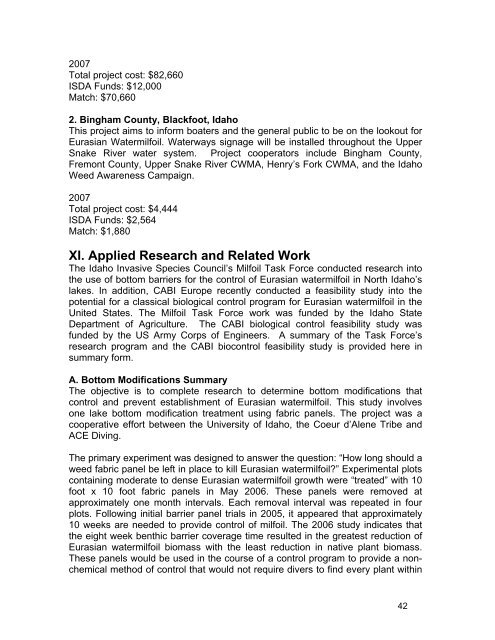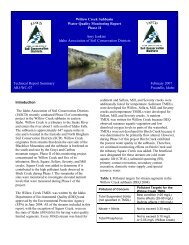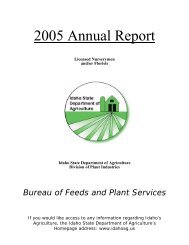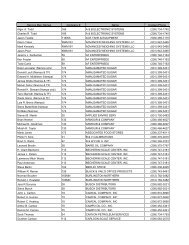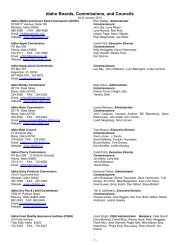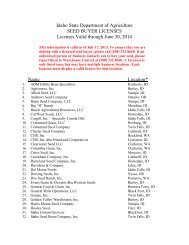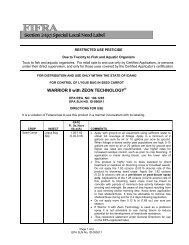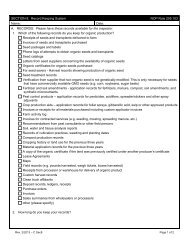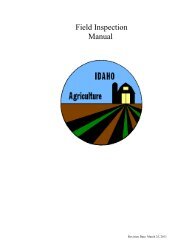2008 Statewide Strategic Plan for Eurasian Watermilfoil in Idaho
2008 Statewide Strategic Plan for Eurasian Watermilfoil in Idaho
2008 Statewide Strategic Plan for Eurasian Watermilfoil in Idaho
You also want an ePaper? Increase the reach of your titles
YUMPU automatically turns print PDFs into web optimized ePapers that Google loves.
2007<br />
Total project cost: $82,660<br />
ISDA Funds: $12,000<br />
Match: $70,660<br />
2. B<strong>in</strong>gham County, Blackfoot, <strong>Idaho</strong><br />
This project aims to <strong>in</strong><strong>for</strong>m boaters and the general public to be on the lookout <strong>for</strong><br />
<strong>Eurasian</strong> <strong>Watermilfoil</strong>. Waterways signage will be <strong>in</strong>stalled throughout the Upper<br />
Snake River water system. Project cooperators <strong>in</strong>clude B<strong>in</strong>gham County,<br />
Fremont County, Upper Snake River CWMA, Henry’s Fork CWMA, and the <strong>Idaho</strong><br />
Weed Awareness Campaign.<br />
2007<br />
Total project cost: $4,444<br />
ISDA Funds: $2,564<br />
Match: $1,880<br />
XI. Applied Research and Related Work<br />
The <strong>Idaho</strong> Invasive Species Council’s Milfoil Task Force conducted research <strong>in</strong>to<br />
the use of bottom barriers <strong>for</strong> the control of <strong>Eurasian</strong> watermilfoil <strong>in</strong> North <strong>Idaho</strong>’s<br />
lakes. In addition, CABI Europe recently conducted a feasibility study <strong>in</strong>to the<br />
potential <strong>for</strong> a classical biological control program <strong>for</strong> <strong>Eurasian</strong> watermilfoil <strong>in</strong> the<br />
United States. The Milfoil Task Force work was funded by the <strong>Idaho</strong> State<br />
Department of Agriculture. The CABI biological control feasibility study was<br />
funded by the US Army Corps of Eng<strong>in</strong>eers. A summary of the Task Force’s<br />
research program and the CABI biocontrol feasibility study is provided here <strong>in</strong><br />
summary <strong>for</strong>m.<br />
A. Bottom Modifications Summary<br />
The objective is to complete research to determ<strong>in</strong>e bottom modifications that<br />
control and prevent establishment of <strong>Eurasian</strong> watermilfoil. This study <strong>in</strong>volves<br />
one lake bottom modification treatment us<strong>in</strong>g fabric panels. The project was a<br />
cooperative ef<strong>for</strong>t between the University of <strong>Idaho</strong>, the Coeur d’Alene Tribe and<br />
ACE Div<strong>in</strong>g.<br />
The primary experiment was designed to answer the question: “How long should a<br />
weed fabric panel be left <strong>in</strong> place to kill <strong>Eurasian</strong> watermilfoil?” Experimental plots<br />
conta<strong>in</strong><strong>in</strong>g moderate to dense <strong>Eurasian</strong> watermilfoil growth were “treated” with 10<br />
foot x 10 foot fabric panels <strong>in</strong> May 2006. These panels were removed at<br />
approximately one month <strong>in</strong>tervals. Each removal <strong>in</strong>terval was repeated <strong>in</strong> four<br />
plots. Follow<strong>in</strong>g <strong>in</strong>itial barrier panel trials <strong>in</strong> 2005, it appeared that approximately<br />
10 weeks are needed to provide control of milfoil. The 2006 study <strong>in</strong>dicates that<br />
the eight week benthic barrier coverage time resulted <strong>in</strong> the greatest reduction of<br />
<strong>Eurasian</strong> watermilfoil biomass with the least reduction <strong>in</strong> native plant biomass.<br />
These panels would be used <strong>in</strong> the course of a control program to provide a nonchemical<br />
method of control that would not require divers to f<strong>in</strong>d every plant with<strong>in</strong><br />
42


